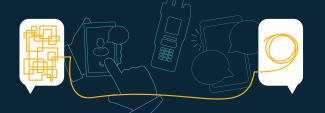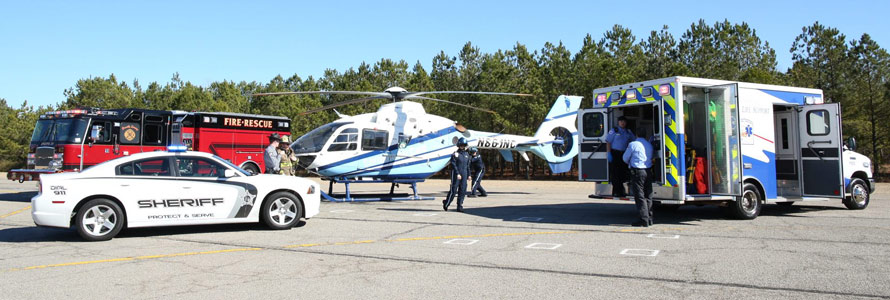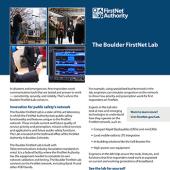Summary
Burleson County is a small, rural county east of Austin in Texas. The Burleson County Sheriff’s Office serves the county through law enforcement, corrections, and dispatch services. The Sheriff’s Office launched its drone program to enhance situational awareness during emergencies and planned events. As a rural county, connectivity is key, and FirstNet ensures footage from the drones can be streamed back in real time to decision makers on the ground.
Guest
Tom Randall
FirstNet Authority Senior Public Safety Advisor
Gene Hermes
Sheriff, Burleson County Sheriff’s Office, Texas
John Pollock
Chief Deputy, Burleson County Sheriff’s Office, Texas
Transcript
Preview
This podcast was recorded on Thursday, May 13, 2021
Narrator: You're listening to Public Safety First, a podcast to help you learn about the First Responder Network Authority and how you can be part of the future of public safety technology.
And now, your host.
This podcast was recorded on Thursday, May 13, 2021
Narrator: You're listening to Public Safety First, a podcast to help you learn about the First Responder Network Authority and how you can be part of the future of public safety technology.
And now, your host.
Tom Randall: Welcome to the Public Safety First podcast. I'm Thomas Randall and I serve as Senior Public Safety Advisor for the First Responder Network Authority. Today, I'm joined by Chief Deputy John Pollock and Sheriff Gene Hermes of the Burleson County Sheriff’s Office in Caldwell, Texas. Prior to joining the FirstNet Authority, I had the pleasure of working alongside with these gentleman as colleagues from my days back in Brazos County. I actually started my career in Burleson County as a patrol deputy at the age of 18 years old. Retired from there and went to work for Brazos County. That’s where John Pollock and I got to working together as colleagues on the patrol division, and I worked real closely with Gene Hermes while he was Chief Deputy at the Burleson County Sheriff’s Office, and now he is the sheriff there. So, we have quite a bit of history between us. Throughout our conversation today, you’re even going to hear them call me Tommy, because I did start at such an early age, and all these folks know me pretty well. So, let’s go ahead and get started with the podcast.
Sheriff Gene Hermes: I'll start this real quick, the very first initial reason to get this drone is we have worked several cases – we've had missing persons, children, elderly people. And, you know, when someone goes missing and they're out in the woods, when you're on foot, it just makes it really difficult to try to find somebody in a timely manner, especially when you have the elements of heat, cold, rain, stuff like that. So, our initial thing was to try to look into the drone aspect and then use that to our advantage of trying to find missing persons. And it really helped us out.
We've had numerous floods in this area that we've used it to launch it and then see exactly what our capabilities would be to help rescue people from residences and things. And it's just grown from there from our original drone, which was donated by one of our local oil companies. So, we had to upgrade and we've upgraded into a really nice drone. And I'm kind of turned over to Chief Pollock because there's just so much more to it. I'll let him jump in on this part.
Chief Deputy John Pollock: So, as the sheriff said, several years ago, there was a drone that was donated to the Burleson County Sheriff's Office. We actually had two drones that were initially donated. As that drone, toward the end of 2019 get into early 20, we started seeing that we had some battery issues. They were not replaceable. So, we went ahead and asked for and budgeted an upgrade, which has night vision, infrared capabilities. We don't have the actual hooks for it, but it will carry a small payload if needed. But one of the features that we got with it was the software, which allows us to live stream the actual footage live from the drone back to any device. And so, we will send that either to a laptop or back to our command center. And so, we have, kind of, decided to stay with this drone program. Our drone operator, he uses a FirstNet device that we're actually looking to upgrade and gain a little bit better capabilities within his vehicle. But we're using FirstNet to actually power the drone’s capabilities of feeding that video back. So, for instance, the drones up a couple of months ago, it was in Milam County on a train derailment and we sent our drone operator to the next county over. But the sheriff and I were able to sit there and monitor everything that was happening just down the hall in our conference room. So, the capabilities with this new drone, it stays up longer, obviously, you know, any time you upgrade, of course, more money, but it means better capability. So, we have enough battery capability to keep this drone up continuously as far as, you know, bring it down, put a new battery in. By the time we cycle through the charging of the batteries, we can keep it up for an extended period of time.
Tom Randall: This project was so important to you all that, from as I understand it, you deferred a vehicle in order to be able to purchase this.
Chief Deputy John Pollock: Yes. And it was just under the cost of what a new patrol vehicle would have been. We paid about $32,000 for the drone package and we actually put it in as a vehicle. And that's exactly what it is for us. It flies. You know, you look at the fact that we're a rural county, a lot of area, and we're not heavy on manpower. And so, the drone capabilities to be able to have it up, to be able to kind of be a force multiplier, it's a $32,000 aircraft as opposed to the helicopter option, which is a $6 million aircraft, which we'd never be able to do that. So, just the operating cost, the force multiplier, the abilities in the air that it gives us, kind of, overwatch for the safety of our staff.
So, we don't just use it for law enforcement purposes. We've deployed on, like I said, the train derailment in Milam County. The fire department will call us if they have a grass fire. So, we will send it out. We'll help them get some videos if they have a large grass fire to kind of get a good idea of where they need to place their apparatus to help contain that. We have put it overhead to be able to watch before we've hit houses with the local SWAT teams, surrounding county SWAT teams that have come to help us. We've been able to get intel and overwatch on that.
Tom Randall: When you talked about the application that you're using to push that video from the controller, how important is it for you to be able to get that video to the command staff, the sheriff, your command center or even during the train derailment? How important is FirstNet in providing that that connectivity?
Chief Deputy John Pollock: Well, the ability to live stream is just what it is. I mean, you're seeing it live. With using the FirstNet technology, the speeds that we've been able to connect and the reliability of it. It's, we're seeing, we've actually done tests of standing in front of the drone and looking in the conference room and the delay is just very minimal. So, you know, when you're talking about a live video, that's crucial because you could have a threat that could appear. And what the drone operator's seeing live or what the commanders are seeing to make some type of a decision, that has to be a reliable device. So, using FirstNet, we've been pleased so far with its abilities and we've operated in some pretty rural areas with that device. And it has not let us down yet.
Tom Randall: Well that is what we like to hear. In fact, I remember you telling me that you all did your own impromptu testing of the network to ensure connectivity. Tell me more about that.
Chief Deputy John Pollock: Yeah, so I carry my FirstNet device everywhere I go. Last summer, was down at the coast and was fishing offshore at the rigs, which are about nine miles offshore off Matagorda. And the sheriff and I had been on a phone call and we actually wanted to test the system, the LMR [land mobile radio]. And I was able to, through that system, through the radio system, call the sheriff and through that radio transmission nine miles offshore. And he's sitting back here in Caldwell. So, huge, huge capability for us there.
Sheriff Gene Hermes: Right. And another addition to that, an old employee here was off in Tennessee. This has been when we first got our phones, was off in Tennessee and me and this employee was talking back and forth and I know it was still within, you know, not out in the middle of dadgum gulf like that, or out in a gulf, but still from Tennessee to Caldwell, Texas. It was just like we were sitting side by side. Very clear. I mean, it was great.
Chief Deputy John Pollock: Let me tell you one more thing about our drone itself, the vehicle that it's in, it belongs to the pilot. He's our CID [Criminal Investigations Division] lieutenant. And he's our program coordinator for the drones. He has everything in the car, everything charges there. The drone's in a case. He has all the monitors. When he pops his back open, he drops the monitor down, he gets the drone up, it's ready to go. So, he doesn't have to come back to the office and pull it out of a closet. When we call him, whenever he gets on site, basically, he's got to do a quick notification to any local airports and do a quick flight plan. And he's up in the air pretty quickly. So, it's a device that we keep on him around the clock and ready to go. And when he's not here, it has the capabilities of our backup pilot for him to have access to it, to put it up as needed.
Sheriff Gene Hermes: And y'all may know this already, but he is actually a certified pilot, drone pilot. He went through extensive training to do this and he stays in contact with the FAA [Federal Aviation Administration]. He has to be, anytime he launches that drone, he has to contact local airports and he stays in contact with them. But a very extensive training he went through to get that pilot's license.
Tom Randall: So, I want to ask one other thing about the drone equipment. I know we had talked about how you all were looking to upgrade some of the connectivity to your drone operator's vehicle. And being that you all are in a rural county and the majority of the counties surrounding Burleson County are rural counties, taking advantage of that rural Band 14 was important. How important is that not only in Burleson County, but when you guys are traveling out in your regional response to be able to touch those Band 14 towers for FirstNet?
Chief Deputy John Pollock: Well, first of all, it's very crucial, as you know. We haven't pulled the trigger yet, but we are really close in this next budget going in and adding the capabilities within that drone unit to boost that ability. So, we want him to have a larger device, a bigger device, a more solid device that that can really reach out and grab those bands. And so, yes, when you look at, Burleson County is rural, if we get over to certain parts of the county, you know, we're able to, kind of, hit off of some, the bigger Brazos County, Bryan-College Station towers and networks but there's some place we get and it sometimes can reduce. And so, we've been contacted by Brazos County, Bryan PD a couple of times because they know our capabilities.
One of the things I didn't mention before, we've actually used the drone to attempt to locate heat signatures or bodies in the water. We've had a couple of drownings and we've flown it over the water to see if we could find the individual floating or see something underneath the surface. But if we're called to Lee County, to Milam County, even to Robertson County, we are getting into very rural areas much like ours. And so, having the ability to have something to grab that signal better to be able to use it effectively and efficiently is key.
Our drone operators, when they get on the scene, it's not just the sheriff and I that can log in. They can instantly give access to anybody. So, if it's Sheriff Yezak in Robertson County and he's on scene and he's in command, they can immediately give him a quick log in and he can be up on any of his devices in his command center within just a couple of minutes as well as us, if we chose to be. So, that's another huge component that we can not just offer the service, but then we can offer their command staff the ability to monitor it.
Tom Randall: All right, so speaking of that, then, let's go to the Milam County train derailment. Explain to us how you guys got involved and what was the purpose for the request up to Milam County, and what did you all use the drone for?
Chief Deputy John Pollock: So, when the train derailment occurred, our lieutenant had received a phone call from the Milam County Sheriff's Office. They knew that we had that resource here and so he deployed over there. Was, I believe, one of the first law enforcement drones there. I think there was another individual with a private drone. But as far as law enforcement goes, he was able to get there and get a site set up and launch. He was able to provide the command staff the video so they could see overhead what they were looking at. And I know we were the first air unit there starting to provide a video back to the ground so that they can figure out what they had going on.
Sheriff Gene Hermes: And that part is so important, too, because when you have a train derailment, especially rural like that was, depending on what cars you have, you could have any kind of fuel, you could have hazardous materials. You could have anything, I'm sure they were looking at which cars were off the tracks, what the placards were, what they were carrying. You know, that would take a lot of manpower, a lot of time, to get somebody to walk those tracks and try to get close enough. You didn't have to do that, the drone was able to do it and get the live feed back and they can just see what that drone and get the information they needed to get for that HAZMAT teams.
Tom Randall: So, this was situational awareness that you were not using for your team. You were providing it to College Station HAZMAT. So, College Station Fire Department actually rolled under mutual aid all the way from Brazos County over to Milam County. So, Milam County was bringing in resources from all over the place. And you all were able to share the live stream video with College Station HAZMAT?
Chief Deputy John Pollock: Correct, because of the capabilities we were able to give that quick log on to their staff. They could either monitor it right there with our command vehicle or, and I believe in this case, log on through that DroneSense, which we use to monitor it here. It's just a web-based log on and then you have access to the video. Whatever the drone is seeing, you're seeing it live.
Tom Randall: Did you all have any feedback from the drone operator or from anybody that was involved in that response as to the connectivity or latency on what you all were sending?
Chief Deputy John Pollock: No, because any time it is deployed, we'll also monitor it just to see the capabilities and not just in interest to see what's happening, but also testing to make sure our system's working back here, that we're able to see things live. So, we were testing that as we were deploying and getting ready to go up. We were able to keep that feed up here while he was in the air. And we never had any significant loss of signal during the time he was flying. And he was up for, I know at least 45 minutes to an hour, maybe, if not longer, you know, bringing it back down, obviously, to replace batteries. But he was over there for quite a while.
Tom Randall: Excellent. Are there any events coming up where you all plan to use the drone?
Sheriff Gene Hermes: There's a part of our county that, a little community called Snook. Once a year, they have what they call a Chilifest, and it's a college-base party. And it's a Thursday, Friday, Saturday event. And Friday and Saturday is the busiest days. And we'll have anywhere from, say, 25,000 to upwards of 40,000 people show up to this event. And when this happens, the cell tower that is close by in that area, it can't handle everybody. And then everybody loses phone service. Well, since we've had FirstNet, I mean, it is unreal, the service that we have there and using this drone since we've had, we started it with our last drone and we haven't been able to launch this one because, as you well know, as far as COVID we haven't had a Chilifest. And this makes the second year we're not having it, but we've used that drone, we'll launch it and use it to see what the traffic is like, because, there will be three or four miles of traffic just stopped and backed up waiting to get into this party. But we use that drone for the safety of the people there, the kids there, make sure everybody stays safe. To be able to use that that FirstNet service, I mean, we have had no problems with it at all. With that many people there, you would think, well we wouldn't be able to use for the live feed we're able to watch what's going on. And it is just unreal.
Tom Randall: And without the ability to do that through FirstNet, you really don't have a whole lot of other options available to you, do you Sheriff?
Sheriff Gene Hermes: No, because the only thing that we could do if we didn't have FirstNet, we would have to have a helicopter flying over or we could fly the drone and we could record it and watch it after the fact. But that does us no good when we're in a situation of if something was to happen. Well, during the middle of working the event you're always looking at what can I do better? What do we need to do here to make this safer? And with that drone up and being on that live feed, if you start having problems in certain areas, you can take care of that at the moment, instead of waiting until later. And that's what that live feed does for us. If we start seeing traffic backed up for miles, we can get it done. If we've got somebody that's hurt and we need to get an ambulance in there – well, we can see exactly where the ambulance is and we can dispatch law enforcement to get them, get the ambulance moving. There have been incidents where we've had to do that, you know, and it's just very, very amazing what we can do with that.
Tom Randall: So, just to give you all some context of where this is, Brazos County is where Texas A&M University is, with 70,000 students, Burleson County is to the west. Snook is about 20 minutes from College Station, 30 minutes. Sheriff, what is our normal population in Burleson County? I know we were at about 17,000. Where are we at today?
Sheriff Gene Hermes: I think it's a little over 19,000 now
Chief Deputy John Pollock: Yeah, Tom, we spent, ooh I don't know exactly what it was, but for the software, it was probably a couple thousand dollars for the license, which is a good chunk of change for a rural county. But we couldn't have made that investment unless we had a reliable network to use it on. And so, if we didn't have the FirstNet component and if, like the sheriff said, if that cell tower is bombarded by all the college student traffic and all the partygoers, and it knocks us offline, then ultimately, our live feed would be dead at that point. So, while we haven't been able to use it at Chilifest, next time Chilifest is here, and it'll come back, we will be able to live stream. But with the capabilities of the different command structures at Chilifest, you have a main command center, then you've got your traffic guys. It's a lot of abilities. The drone can throw that log in to individuals who could look on their devices, their pads or their computers or wherever they're at and be able to get real time information. And so, the speed of that real time is crucial. It does us no good if there's a 30 second or minute delay. And so, having that reliability is something that we invested in when we bought the software to drive it. And then we rely on FirstNet to actually deliver it.
Tom Randall: Well, thanks a lot, guys. As we close the podcast, I just want to thank you both for what you do, and I look forward to continuing to work with you.
Chief Deputy John Pollock: You're very welcome.
Sheriff Gene Hermes: Tommy, I gotta add this. When you first came over and we talked about this FirstNet service. I won't say I was skeptical, but I was like, OK, this is new. Is this too good to be true? But I'm going to tell you right now, I would not want to have to do without this FirstNet in our agency. This has become part of our agency. It is vital to our agency for our operations. And, yeah, moving forward, we're not going to change, as far as I'm concerned. We want to keep moving forward with whatever technology there is because we almost have gotten to where we can't operate without it.
Tom Randall: That's good to hear and I appreciate the close partnership that we maintain on this. Thank you, Sheriff Hermes and Chief Deputy Pollock for taking the time to speak with us today. It’s been great to have you both on the podcast.
Narrator: Thanks for listening today. We're excited to have you join our podcast community. Make sure to subscribe on iTunes, SoundCloud, and YouTube. You can learn more about the First Responder Network Authority at FirstNet.gov and learn about FirstNet products and services at FirstNet.com.























